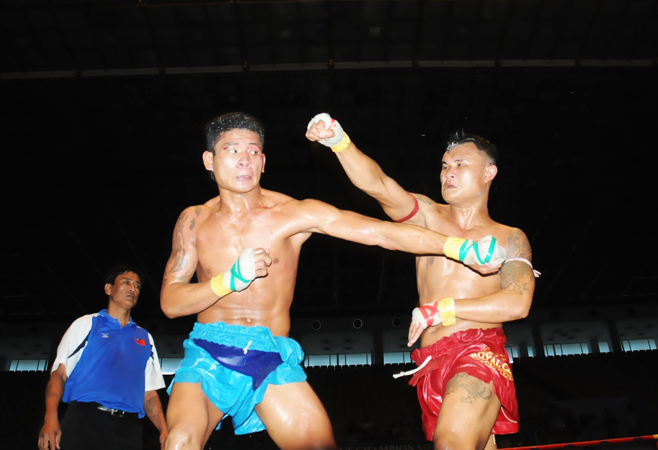Culture
Myanmar Kickboxing
- Details
- Hits: 4284
 Myanmar Kickboxing
Myanmar Kickboxing
Myanmar has a tradition of kickboxing that's said to date back to the Bagan era. although the oldest written references are found in chronicles of warfare between Myanmar and Thailand during the 15th and 16th centuries. Myanmar kickboxing (Myanma Let-hwei) is very similar in style to Siamese kickboxing or Muay Thai.
The martial art's status has raised perceptibly and nowadays occasional championship matches are also occasionally held at Aung San Stadium and Thuwanna Indoor Stadium in Yangon.
Rules & Regulations Anything goes in the ring. All surfaces of the body are considered fair targets and any part of the body except the head may be used to strike an opponent. Common blows include high kicks to the neck. elbow thrusts to the face and head. knee hooks to the ribs and low crescent kicks to the calf. A contestant may even grasp an opponent's head between his hands and pull it down to meet an upward knee thrust. Punching is considered the weakest of all blows and kicking merely a way to 'soften up' one's opponent; knee and elbow strikes are decisive in most matches. The structure and limitations of each match varies with its context and with the calibre of the participants. Unlike Thai boxing. which has borrowed a great deal from the Queensbury rules in international or Western boxing. Myanmar boxing represents a more traditional form once shared by the two countries. Rules tend to follow situational norms; fighters. managers and judges get together before each match and work out time limits and scoring criteria. In the simplest rural matches. fought in a dirt circle. there's no time limit and a fighter loses once he has wiped blood from his face or body three times. In more organised amateur matches. boxers fight in square rings (5.8 by 5.5 metres). for three to five rounds of three minutes each. usually with two minutes rest between. Professional matches in larger towns and cities begin with five rounds but may increase round by round to 12 rounds when the scoring is tight - even longer if no clear winner emerges earlier in the match.

The match
When such extensions occur. boxers can request a five-minute rest period for every seven rounds fought. At both amateur and pro matches. two referees officiate in the ring. where there's only one. At ringside are three judges who score the match by pooling their impressions of stamina. skill and bravery. Fighters bandage their hands but do not wear gloves; they fight barefoot except for nylon anklets worn to absorb perspiration. Simple. dark-coloured shorts rather than baggy boxing trunks are usually worn; if the shorts worn by the contestants appear too similar in colour. the fighters may sew coloured bandanas over the front to make it easier for spectators to differentiate the opponents. In championship matches Myanmar fighters wear big. gaudy trunks. Before the match begins each boxer performs a dance-like ritual in the ring to pay homage to Buddha and to Khun Cho and Khun Tha. the nats whose domain includes Myanmar kickboxing. The winner repeats the ritual at the end of the match. A small musical ensemble consisting of drums. hne. cymbals and bamboo clappers performs during the rituals and throughout the match; the volume and tempo of the music rise and fall along with events in the ring. There are no weight divisions in Myanmar boxing. Instead boxers are ranked by skill into first. second. and third class. The best boxers are said to hail from the Ayeyarwady Division. Mandalay Division. Kayin State and Mon State. At present Myanmar's most celebrated boxer is the National Champion Shwe Du Won from Hpa-An. Kayin State.
Myanmar's most famous Myanma Let-hwei teacher is Saya Pan Thu. founder of the Institute of Myanmar Traditional Advanced Boxing and one of three trainers at Yangon University. He comes from a teaching lineage that emphasises Myanmar's most traditional style of kickboxing. but also incorporates a few grappling and wrestling techniques from the judo-like Myanmar art of bando. Due largely to Pan Thu's steady promotion of Myanmar martial arts. the country is on the verge of establishing the Myanma Traditional Boxing Federation. an organisation that will regulate boxing rules. introduce new safety measures to the ring and develop overall professionalism.



